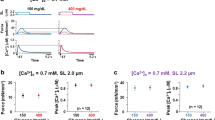Abstract
Exogenously applied fructose-1,6-bisphosphate has been reported to be effective in preventing some damage to the small intestine during ischemia. To determine whether exogenously applied fructose-1,6-bisphosphate protects ileum smooth muscle from damage from hypoxia and from reoxygenation, we examined the effect of fructose-1,6-bisphosphate on the ability of hog ileum smooth muscle to maintain isometric force during hypoxia and to generate isometric force after reoxygenation in the presence of 5 mM glucose. After 180 min of hypoxia, tissues incubated with 20 mM fructose-1,6-bisphosphate maintained significantly greater levels of isometric force than tissues incubated in the absence of exogenous substrate (23% of pre-hypoxia force compared to 16%). During the first contraction following reoxygenation there was a significantly greater force generation in tissues incubated with 20 mM fructose-1,6-bisphosphate during the hypoxia period compared to tissues with no exogenous substrate included during the hypoxia period (29% of pre-hypoxia force compared to 19%). However, glucose always was a better metabolic substrate compared to fructose-1,6-bisphosphate under all experimental conditions. The presence of fructose-1,6-bisphosphate during hypoxia likely improved tissue function by fructose-1,6-bisphosphate entering the cells and acting as a glycolytic intermediate, since during a 120 min period of hypoxia, unmounted ileum smooth muscle metabolized 1,6-13C-fructose-1,6-bisphosphate to 3-13C-lactate. This conversion of 1,6-13C-fructose-1,6-bisphosphate to 3-13C-lactate was inhibited by the addition of 1 mM iodoacetic acid, a glycolytic inhibitor. We conclude that exogenously provided fructose-1,6-bisphosphate does provide modest protection of ileum smooth muscle from hypoxic damage by functioning as a glycolytic intermediate and improving the cellular energy state.
Similar content being viewed by others
References
Hildebrand HD, Zierler RE: Mesenteric vascular disease. Am J Surg 139: 188–192, 1980
Mucha P: Small intestinal obstruction. Surg Clin N Amer 67: 597–620, 1987
Sachs SM, Morton JH, Schwartz SI: Acute mesenteric ischemia. Surgery 92: 646–653, 1982
McCord JM: Oxygen-derived free radicals in post-ischemic tissue injury. N Engl J Med 312: 159–163, 1985
Novelli GP, Livi P, Ghinassi L, Lisi L, Brunelleschi S, Fantozzi R: Superoxide generation by granulocytes during superior mesenteric artery occlusion shock in rabbits. In: G.P. Novelli and F. Ursini (eds). Oxygen Free Radicals In Shock. International Workshop. Karger Publishing, Basel Switzerland, 1986, pp 587–593
Didlake R, Kirchner KA, Lewin J, Bower JD, Markov AK: Attenuation of ischemic renal injury with fructose 1,6-diphosphate. J Surg Res 47: 220–226, 1989
Gregory GA, Welsh FA, Yu ACH, Chan PH: Fructose-1,6-bisphosphate reduces ATP loss from hypoxic astrocytes. Brain Res 516: 310–312, 1990
Kuluz JW, Gregory GA, Han Y, Dietrich WD, Schleien CL: Fructose-1,6-bisphosphate reduces infarct volume after reversible middle cerebral artery occlusion in rats. Stroke 24: 1576–1583, 1993
Lazzarino G, Numinen ME, Tavazzi B, Cerroni L, DiPierro D, Giardina B: Preserving effect of fructose-1,6-bisphosphate on highenergy phosphate compounds during anoxia and reperfusion in isolated Langendorf-perfused rat hearts. J Mol Cell. Cardiol 23: 13–23, 1991
Markov AK, Ogelthorpe NC, Blake TM, Lehan PH, Hellems HK: Hemodynamic, electrocardiographic, and metabolic effects of fructose diphosphate on acute myocardialischemia. Am Heart J 100(5): 639–646, 1980
Sawohuck A, Canal D, Slaughter M, Bearman D, O'Conner T, Grosfeld JL: A comparison between fructose-1,6-diphosphate, glucose, or normal saline infusions and species-specific blood exchange transfusions in the treatment of bowel ischemia. Surgery 100(4): 665–670, 1986
Sun J, Farias LA, Markov AK: Fructose-1,6-diphosphate prevents intestinal ischemic reperfusion injury and death in rats. Gastroenterology 98: 117–126, 1990
Tavazzi B, Cerroni L, Di Pierro D, Lazzarino G, Nuutinen M, Starnes JW, Giardina B: Oxygen radical injury and loss of high energy compounds in anoxic and reperfused rat heart: Prevention by exogenous fructose-1,6-bisphosphate. Free Rad Res Comm 10(3): 167–176, 1990
Trimarchi GR, DeLuca R, Campo GM, Scuri R, Caputi AP: Protective effects of fructose-1,6-bisphosphate on survival and brain putrescine levels during ischemia and recirculation in the mongolian gerbil. Stroke Suppl IV: 171–173, 1990
Galzinga L, Rizzoli V, Bianchi M. Rigobello MP, Scuri R: Some effects of fructose, 1,6-disphosphate on rat myocardial tissue related to membrane-stabilizing action. Cell Biochem Funct 7: 91–96, 1989
Hardin CD, Roberts TM: The metabolism of exogenously applied fructose-1,6-bisphosphate in hypoxic vascular smooth muscle. Am J Physiol 267(36): H2325–2332, 1994
Fasolato C, Deana R, Rigoni F, Galzinga L: Fructose-1,6,diphosphate improves the motility and other functions of bovine spermatozoa. Med Sci Res 15: 203–204, 1987
Lazzarino G, Cattani L, Costrini R, Mulieri L, Candiani A, Galzinga L: Increase of intraerythrocytic fructose-1,6-diphosphate after incubation of whole human blood with fructose-1,6-diphosphate. Clin Biochem 17: 42–45, 1984
Hardin CD, Roberts TM: Compartmentation of glucose and fructose-1,6 bisphosphate metabolism in vascular smooth muscle. Biochemistry 34(4): 1323–1331, 1995
McCord JM, Russell WJ: In: Cerutti, Fridovich, and McCord JM (eds). Oxy-Radicals in Molecular Biology and Pathology. Alan Liss Inc., New York, 1988, pp. 27–35
Wiseman RW, Hardin CD, Kushmerick MJ, Dykens JA: 31P-NMR assessment of specific impairment of creatine kinase function following hypoxia: Implications for reperfusion injury. FASEB J 5(5):A5255, 1991
Author information
Authors and Affiliations
Additional information
This work was supported in part by NIH (HL48783 to CDH), NSF (Instrumentation Grant 8908304), and the Department of Physiology of the University of Missouri. T. Juergens was supported by the School of Medicine and the Department of Physiology of the University of Missouri.
Rights and permissions
About this article
Cite this article
Juergens, T.M., Hardin, C.D. Fructose-1,6-bisphosphate as a metabolic substrate in hog ileum smooth muscle during hypoxial. Mol Cell Biochem 154, 83–93 (1996). https://doi.org/10.1007/BF00248465
Received:
Accepted:
Issue Date:
DOI: https://doi.org/10.1007/BF00248465




